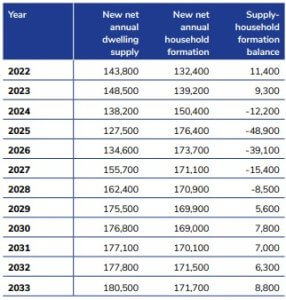NHFIC forecasts house building to decline until after 2025-26
Martin Sinclair Apr 05

This month The National Housing Finance and Investment Corporation (NHFIC) released their latest ‘State of the Nation’s Housing 2022-23’ research report. Among it’s key findings, the report found that housing starts would drop to 127,500 dwellings in 2023/24 from a peak of 148,500 in the year 2022/23. Apartments and medium density dwellings will be 40% lower than levels seen in the late 2010s.

Source: NHFIC
Construction activity was at a record high in mid-2022, with around 244,000 dwellings under construction. Strong demand coupled along with tight supply in both labour and materials, COVID-19 restrictions and inclement weather all put significant pressure on the construction industry, seeing nearly 28,000 delayed projects in 2022.
“A large number of approved projects in NSW have been placed on hold because the return is no longer attractive. Rising construction costs are squeezing margins for developers; higher interest rates are reducing the amount of capital buyers can borrow,” the report states.
Surge in household formation
Much stronger-than-expected growth in overseas migration is now expected to see a shortfall in housing supply of 106,000 dwellings to 2027.
Prevailing interest interest rate ‘crisis’, coupled with challenging supply conditions, have led to slower housing starts. Along with building firms collapsing at double the pace of the previous 12 months, the decline in house prices will put further downward pressure on residential construction.
Some input costs have begun to decline, however, such as with timber and structural steel. But while the government’s Housing Australia Future (HAFF) bill is debated in parliament, with the aim to deliver 30,000 affordable and social housing dwellings using a stock-market investment model to fund the construction, new housing from the scheme will have little impact on construction sector growth until at least 2026 after which the sector is forecast to start growing again.










